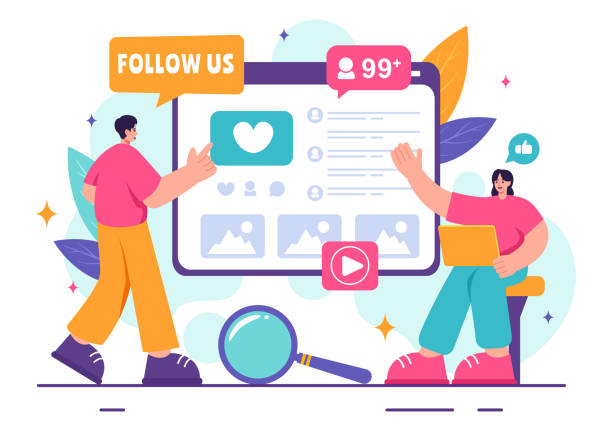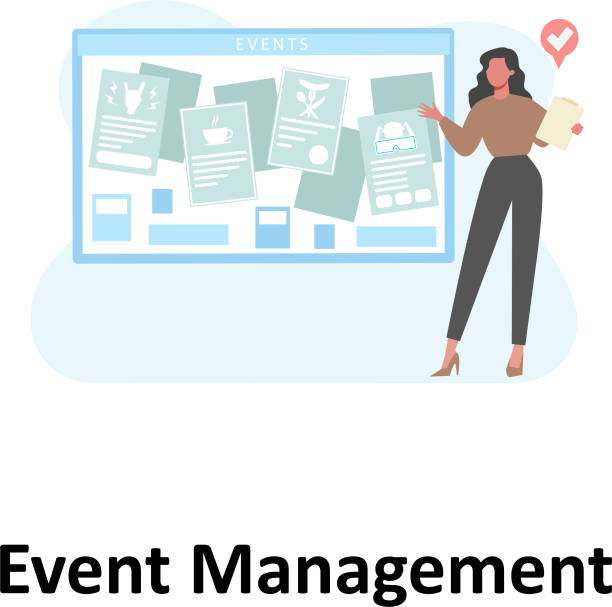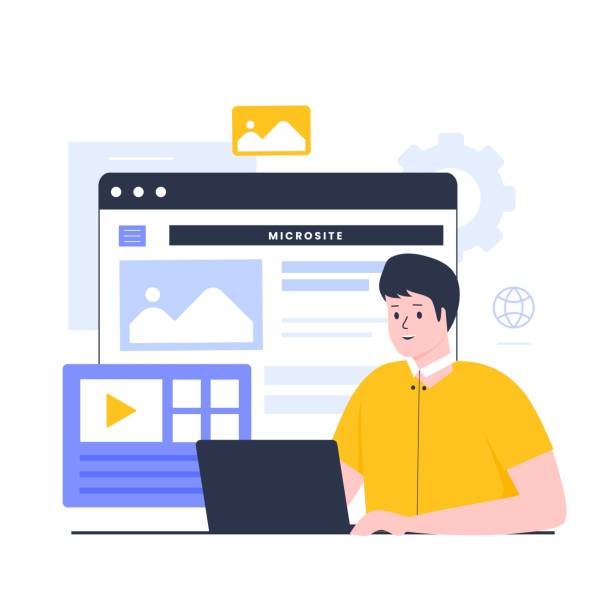Introduction to SEO-Optimized Website Design and Its Importance

In today’s digital world, having a website is just the first step.
What truly matters is the visibility of this website among a multitude of competitors.
This is precisely where the concept of #SEO_optimized_website_design comes in.
SEO-optimized website design means building a website that adheres to all principles and rules of search engine optimization (SEO), so that search engines like Google can easily understand its content, index it, and display it to users in top search results.
This is a complex but absolutely essential process for any online business.
The importance of SEO is not limited to increasing #website_traffic; rather, it means attracting targeted and high-quality traffic, which significantly increases the likelihood of converting them into customers or loyal readers.
An optimized website builds user and search engine trust and enhances your online credibility.
This is a long-term investment that brings sustainable and positive results for your business.
The educational section of this article will help you gain a deeper understanding of the various dimensions of SEO and realize why this concept is no longer an option, but an undeniable necessity for survival and growth in the online space.
For more information on the importance of SEO, you can refer to Wikipedia.
Did you know that 94% of users’ first impressions of a business are related to its website design? With professional corporate website design by **Rasawb**, turn this initial impression into an opportunity for growth.
✅ Attract more customers and increase sales
✅ Build credibility and trust in the audience’s eyes⚡ Get a free website design consultation!
Key Principles of On-Page SEO

On-Page SEO refers to all actions you can directly perform on your website pages to improve rankings.
These principles form the foundation of an SEO-optimized website design, and without them, other efforts may be futile.
The most important aspects of On-Page SEO include optimizing #Page_Title (Title Tag), #Meta_Description, appropriate use of #Keywords in content, SEO-friendly URL structure, image optimization (using proper Alt Text), and using appropriate headings (H1, H2, H3) to organize content.
Your page title should include the main keyword and be attractive enough for users to click.
The meta description, although not directly affecting ranking, can increase the click-through rate (CTR).
Your content should be rich, relevant, and naturally include keywords, not by keyword stuffing.
The URL structure should be short, descriptive, and contain keywords.
Optimizing images with Alt Text is crucial not only for SEO but also for website accessibility.
This section provides comprehensive guidance for implementing these specialized principles to ensure every page of your website is optimized in the best way for search engines.
The Role of Keyword Research in SEO Strategy

Keyword Research is the beating heart of every successful SEO strategy and the most fundamental step in SEO-optimized website design.
Without a precise understanding of the words users search for to find your products or services, you cannot produce relevant and targeted content and ultimately achieve top rankings.
This process involves identifying #Relevant_Keywords, analyzing their search volume, examining the level of competition, and discovering #Long-Tail_Keywords, which often have higher conversion rates.
Tools like Google Keyword Planner, SEMrush, Ahrefs, and KWFinder help you identify high-potential keywords.
The ultimate goal is to find a list of keywords that have both a suitable search volume and less competition, allowing you to easily rank for them by producing valuable content.
This is an analytical process that requires precision and a deep understanding of user needs and behavior.
By studying this educational section, you will learn how to build a strong keyword research strategy that leads to targeted traffic and increased visibility for your website.
For a better understanding of On-Page elements, please refer to the table below:
| Factor | Description | Importance |
|---|---|---|
| Page Title (Title Tag) | Text displayed in browser tab and search results | High |
| Meta Description | Short description of the page in search results | Medium (impact on CTR) |
| Headings (H1-H6) | Categorization of different content sections | High |
| Image Alt Text | Explanation of image content for search engines | Medium |
| URL Structure | Website address of each page | High |
| Content Quality and Length | Comprehensive, accurate, and user-friendly content | Very High |
Technical SEO and Site Infrastructure

Alongside content and keywords, the technical aspects of a website play a vital role in SEO-optimized website design.
#Technical_SEO ensures that your website is optimized for crawling and indexing by search engines.
Factors such as #Site_Speed, #Mobile-Friendliness, the presence of an #SSL_Certificate (HTTPS), proper #Sitemap.xml structure, and the #robots.txt file are highly important.
Site loading speed not only positively impacts user experience but is also one of Google’s ranking factors.
Your website must be fully responsive to display correctly on any device, including smartphones and tablets.
Using HTTPS instead of HTTP ensures the security of your website and is approved by Google.
An XML sitemap helps search engines better understand your website’s structure, while the robots.txt file tells them which sections not to crawl.
These specialized aspects provide the necessary infrastructure for SEO success, and a website with good design and excellent content cannot reach its peak performance without a strong technical infrastructure.
Does your company’s website create a professional and lasting first impression in the minds of potential customers? Rasawb, with its professional corporate website design, not only represents your brand’s credibility but also paves a path for your business growth.
✅ Create a powerful and reliable brand image
✅ Attract target customers and increase sales
⚡ Get free consultation
Effective Link Building Strategies (Off-Page SEO)

While On-Page SEO focuses on optimizing internal website elements, Off-Page SEO deals with factors outside your website’s direct control that influence rankings.
The most important factor in Off-Page SEO is #Link_Building or #Backlinks.
Backlinks are essentially votes of confidence from other websites for your content.
The more numerous and higher quality the backlinks pointing to your website, the more credibility and authority search engines will assign to your website.
This means that an SEO-optimized website design alone is not enough and must be complemented by strong link-building strategies.
Effective link-building strategies include creating shareable content that naturally attracts backlinks, guest posting on relevant and reputable websites, participating in online forums, and even digital PR to disseminate newsletters and news articles.
It is important to note that the quality of links is far more important than their quantity.
Backlinks from spammy or irrelevant websites can harm your SEO.
For more information on link-building strategies and principles, you can use reputable news and analytical resources in the SEO field to stay updated with the latest techniques.
Moz Link Building Guide is a good resource for this purpose.
The Importance of Producing Valuable and SEO-Optimized Content

Content is king; this is a phrase we’ve heard many times in the SEO world, and it still holds true.
No #SEO_optimized_website_design can succeed without high-quality and valuable content.
Producing #SEO_optimized_content goes beyond merely writing text; it involves understanding audience needs, keyword research, and providing information that is both engaging and useful to users, and easily understandable and rankable by search engines.
Your content should be comprehensive, accurate, unique, and up-to-date.
Content types can include blog articles, how-to guides, videos, infographics, and case studies.
The goal is to answer users’ questions and solve their problems.
Appropriate use of keywords, logical content structuring with headings, internal linking to relevant pages, and optimization for readability are among the actions that make your content SEO-friendly.
Engaging or thought-provoking content can also increase user interaction and help them stay longer on the site, which is a positive signal for Google.
Investing in high-quality content production is an investment in the future of your website’s SEO, and visitors attracted through excellent content are highly likely to become loyal customers.
User Experience (UX) and Its Impact on SEO

It might seem that #User_Experience (User Experience or UX) only pertains to visual design and ease of website use, but in reality, UX is a very important and indirect factor in SEO-optimized website design.
Google is increasingly focusing on user experience signals for website ranking.
Factors such as #Page_Loading_Speed, #Mobile_Compatibility, ease of #Site_Navigation, Dwell Time, Bounce Rate, and Core Web Vitals (including Largest Contentful Paint, First Input Delay, Cumulative Layout Shift) all impact user experience and, consequently, your SEO ranking.
A website that loads quickly, is easily accessible on various devices, and simply provides the information users need will likely have a lower bounce rate and users will spend more time on it.
These signals indicate to Google that your website has high-quality content and provides a positive user experience, which will ultimately help improve your ranking.
This analytical section shows you how optimizing UX can significantly contribute to your SEO success and why these two concepts are inseparable.
| Tool Name | Primary Use | Key Features |
|---|---|---|
| Google Search Console | Monitoring site performance in Google searches, identifying crawl errors | Performance reports, indexing, security, Core Web Vitals |
| Google Analytics | Website traffic analysis, user behavior, traffic sources | Demographic data, conversion rates, user flow |
| Google Keyword Planner | Keyword research, estimating search volume and competition | Suggest new keywords, campaign planning |
| Ahrefs | Backlink analysis, keyword research, competitor analysis | Domain authority check, lost links analysis |
| SEMrush | Comprehensive SEO tool, keywords, competitor analysis, content | Rank tracking, content gap analysis, idea generation |
Data Analysis and SEO Tools

After implementing SEO-optimized website design strategies, the next step is performance monitoring and analysis.
Without proper data and tools, it will be difficult to identify strengths and weaknesses and make necessary improvements.
#SEO_Tools play a vital role in collecting and analyzing this data.
Google Search Console helps you understand how Google interacts with your website, identify crawl errors, view your keyword performance, and check issues such as security problems or Core Web Vitals.
Google Analytics provides deep insights into user behavior, traffic sources, time spent on site, and conversion rates.
Using these tools allows you to optimize your SEO strategy with an analytical perspective and make data-driven decisions.
Other tools like Ahrefs and SEMrush provide more comprehensive information on backlinks, competitor analysis, and keyword research.
Continuous monitoring of keyword rankings, organic traffic, and conversion rates through these tools helps you stay on the right track and achieve your SEO goals.
This section is an expert guide to maximizing the utilization of these powerful tools.
Are you worried about losing customers because you don’t have a professional e-commerce website?
Forget these worries with e-commerce website design by Rasawb!
✅ Significant increase in sales and conversion rate from visitor to customer
✅ Professional and user-friendly design that builds customer trust
⚡ Get a free consultation from Rasawb
Challenges and Future Trends in SEO-Optimized Website Design

The world of SEO is a dynamic and constantly changing environment.
Google’s algorithms are regularly updated, and with each update, new approaches and priorities emerge.
Therefore, a successful SEO-optimized website design requires continuous updating and adaptation.
Upcoming challenges include adapting to #New_Google_Algorithms, the emergence of #Voice_Search, the increasing role of #Artificial_Intelligence in search, and the importance of the E-A-T concept (Expertise, Authoritativeness, Trustworthiness).
AI algorithms like BERT and RankBrain are better understanding user intent and more complex content.
Voice search also requires different approaches to keyword and content optimization.
Furthermore, Google is placing greater emphasis on the credibility, expertise, and trustworthiness of websites.
This means that producing accurate and correct content by specialists, and having reliable sources for information, will be of particular importance.
This section includes thought-provoking content and introduces you to new news trends to prepare you for the future of SEO and its challenges.
To remain competitive, you must constantly learn and update your SEO knowledge and strategies, and use these challenges as opportunities for growth.
Conclusion and Next Steps for SEO Success

At the end of this comprehensive guide, it can be said that SEO-optimized website design is not a one-time process, but a continuous and ongoing journey.
Success in SEO requires a combination of specialized knowledge, precise On-Page and Off-Page strategies, high-quality content production, technical optimization, attention to user experience, and continuous data analysis.
Each of these components is important on its own, but their combination and synergy help you achieve brilliant results and stand out among your competitors.
Your next steps for SEO success include: Firstly, regularly monitor your website with tools like Google Search Console and Google Analytics. Secondly, continue to produce fresh, relevant, and valuable content that meets the needs of your audience and answers their questions. Thirdly, seek new opportunities for quality link building. Fourthly, always stay informed about the latest changes and updates to Google’s algorithms and adjust your strategies accordingly.
By following this comprehensive guide and committing to SEO principles, you can ensure that your website is not only seen but also becomes a powerful tool for your business’s growth and success in the online world.
Investing in SEO is investing in the future of your business.
Frequently Asked Questions
| Question | Answer |
|---|---|
| What is SEO-optimized website design? | SEO-optimized website design means creating a website that is not only attractive and user-friendly for users but also has its structure and content optimized for search engines (like Google) to achieve higher rankings in search results. |
| Why is SEO-optimized website design important? | SEO-optimized website design increases your website’s visibility in search engines, attracts more organic (free) traffic, boosts your brand’s credibility and trust, and ultimately leads to increased sales and customers. |
| What are the key factors in SEO-optimized website design? | Key factors include site loading speed, responsiveness (mobile compatibility), proper URL structure, correct use of title and description tags (Meta Title & Description), image optimization, high-quality and user-friendly content, and internal and external link building. |
| What is the role of content in website SEO? | Content is king. High-quality, unique, relevant, and up-to-date content that naturally incorporates target keywords plays a very important role in attracting users and sending positive signals to search engines. |
| How does site speed affect SEO? | Site speed is one of Google’s important ranking factors. Slow websites provide a poor user experience and can lead to an increased Bounce Rate, which harms your SEO ranking. |
| What does site responsiveness mean and why is it important for SEO? | Responsiveness means that your website displays correctly on any device (mobile, tablet, laptop). Since most searches are done via mobile, Google prioritizes responsive sites. |
| How do we choose appropriate keywords for the site? | Choosing appropriate keywords is done by researching and analyzing user and competitor needs. Using tools like Google Keyword Planner, Ahrefs, or Semrush can help in finding high-volume and relevant keywords. |
| What is the importance of internal and external link building in SEO? | Internal link building improves site navigation, distributes Page Authority, and aids search engine crawling. External links (backlinks) from reputable sites are also a sign of your site’s authority and expertise to Google. |
| What is the role of User Experience (UX) in SEO? | Good user experience means ease of use, visual appeal, and user satisfaction. Good UX leads to users staying longer on the site and having more interaction, which are considered positive signals for SEO ranking. |
| What tools are available for website SEO analysis? | There are many tools for SEO analysis, including Google Search Console for checking site performance in search, Google Analytics for traffic analysis, GTmetrix and PageSpeed Insights for speed checks, and paid tools like Ahrefs and Semrush for comprehensive SEO and competitor analysis. |
And other advertising services by Rasawb Advertising Agency:
Smart Data Analysis: An effective tool for customer acquisition through marketing automation.
Smart Direct Marketing: An effective tool for campaign management with custom programming.
Smart Marketing Automation: A blend of creativity and technology for digital branding through intelligent data analysis.
Smart Digital Advertising: Designed for businesses seeking campaign management through precise audience targeting.
Smart Advertorials: An effective tool for online growth through intelligent data analysis.
And over a hundred other services in the field of internet advertising, advertising consultation, and organizational solutions.
Internet Advertising | Advertising Strategy | Advertorial
Sources
Iran Server – SEO-Optimized Website Design
HamyarWP – SEO-Optimized Website Design
Mizbanfa – What is SEO?
Pars Data – SEO Guide
? Is your business ready to leap into the digital world? Rasawb Afarin Digital Marketing Agency provides comprehensive services, including advanced e-commerce website design, professional SEO optimization, and effective social media strategies, paving your way to online success. For more information and expert consultation, contact us.
📍 Tehran, Mirdamad Street, next to Bank Markazi, Southern Kazeroon Alley, Ramin Alley No. 6



